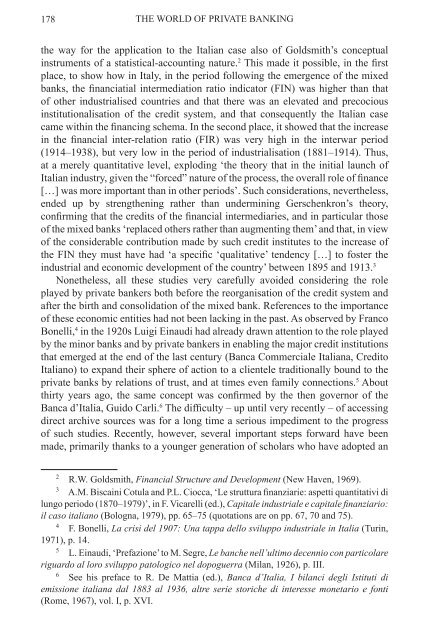the world of private banking
the world of private banking
the world of private banking
You also want an ePaper? Increase the reach of your titles
YUMPU automatically turns print PDFs into web optimized ePapers that Google loves.
178<br />
THE WORLD OF PRIVAtE BANKING<br />
<strong>the</strong> way for <strong>the</strong> application to <strong>the</strong> Italian case also <strong>of</strong> Goldsmith’s conceptual<br />
instruments <strong>of</strong> a statistical-accounting nature. This made it possible, in <strong>the</strong> first<br />
place, to show how in Italy, in <strong>the</strong> period following <strong>the</strong> emergence <strong>of</strong> <strong>the</strong> mixed<br />
banks, <strong>the</strong> financiatial intermediation ratio indicator (FIN) was higher than that<br />
<strong>of</strong> o<strong>the</strong>r industrialised countries and that <strong>the</strong>re was an elevated and precocious<br />
institutionalisation <strong>of</strong> <strong>the</strong> credit system, and that consequently <strong>the</strong> Italian case<br />
came within <strong>the</strong> financing schema. In <strong>the</strong> second place, it showed that <strong>the</strong> increase<br />
in <strong>the</strong> financial inter-relation ratio (FIR) was very high in <strong>the</strong> interwar period<br />
(1914–1938), but very low in <strong>the</strong> period <strong>of</strong> industrialisation (1881–1914). Thus,<br />
at a merely quantitative level, exploding ‘<strong>the</strong> <strong>the</strong>ory that in <strong>the</strong> initial launch <strong>of</strong><br />
Italian industry, given <strong>the</strong> “forced” nature <strong>of</strong> <strong>the</strong> process, <strong>the</strong> overall role <strong>of</strong> finance<br />
[…] was more important than in o<strong>the</strong>r periods’. Such considerations, never<strong>the</strong>less,<br />
ended up by streng<strong>the</strong>ning ra<strong>the</strong>r than undermining Gerschenkron’s <strong>the</strong>ory,<br />
confirming that <strong>the</strong> credits <strong>of</strong> <strong>the</strong> financial intermediaries, and in particular those<br />
<strong>of</strong> <strong>the</strong> mixed banks ‘replaced o<strong>the</strong>rs ra<strong>the</strong>r than augmenting <strong>the</strong>m’ and that, in view<br />
<strong>of</strong> <strong>the</strong> considerable contribution made by such credit institutes to <strong>the</strong> increase <strong>of</strong><br />
<strong>the</strong> FIN <strong>the</strong>y must have had ‘a specific ‘qualitative’ tendency […] to foster <strong>the</strong><br />
industrial and economic development <strong>of</strong> <strong>the</strong> country’ between 1895 and 1913. <br />
None<strong>the</strong>less, all <strong>the</strong>se studies very carefully avoided considering <strong>the</strong> role<br />
played by <strong>private</strong> bankers both before <strong>the</strong> reorganisation <strong>of</strong> <strong>the</strong> credit system and<br />
after <strong>the</strong> birth and consolidation <strong>of</strong> <strong>the</strong> mixed bank. References to <strong>the</strong> importance<br />
<strong>of</strong> <strong>the</strong>se economic entities had not been lacking in <strong>the</strong> past. As observed by Franco<br />
Bonelli, in <strong>the</strong> 1920s Luigi Einaudi had already drawn attention to <strong>the</strong> role played<br />
by <strong>the</strong> minor banks and by <strong>private</strong> bankers in enabling <strong>the</strong> major credit institutions<br />
that emerged at <strong>the</strong> end <strong>of</strong> <strong>the</strong> last century (Banca Commerciale Italiana, Credito<br />
Italiano) to expand <strong>the</strong>ir sphere <strong>of</strong> action to a clientele traditionally bound to <strong>the</strong><br />
<strong>private</strong> banks by relations <strong>of</strong> trust, and at times even family connections. About<br />
thirty years ago, <strong>the</strong> same concept was confirmed by <strong>the</strong> <strong>the</strong>n governor <strong>of</strong> <strong>the</strong><br />
Banca d’Italia, Guido Carli. The difficulty – up until very recently – <strong>of</strong> accessing<br />
direct archive sources was for a long time a serious impediment to <strong>the</strong> progress<br />
<strong>of</strong> such studies. Recently, however, several important steps forward have been<br />
made, primarily thanks to a younger generation <strong>of</strong> scholars who have adopted an<br />
<br />
R.W. Goldsmith, Financial Structure and Development (New Haven, 1969).<br />
<br />
A.M. Biscaini Cotula and P.L. Ciocca, ‘Le struttura finanziarie: aspetti quantitativi di<br />
lungo periodo (1870–1979)’, in F. Vicarelli (ed.), Capitale industriale e capitale finanziario:<br />
il caso italiano (Bologna, 1979), pp. 65–75 (quotations are on pp. 67, 70 and 75).<br />
<br />
F. Bonelli, La crisi del 1907: Una tappa dello sviluppo industriale in Italia (Turin,<br />
1971), p. 14.<br />
<br />
L. Einaudi, ‘Prefazione’ to M. Segre, Le banche nell’ultimo decennio con particolare<br />
riguardo al loro sviluppo patologico nel dopoguerra (Milan, 1926), p. III.<br />
<br />
See his preface to R. De Mattia (ed.), Banca d’Italia, I bilanci degli Istituti di<br />
emissione italiana dal 1883 al 1936, altre serie storiche di interesse monetario e fonti<br />
(Rome, 1967), vol. I, p. XVI.












![[Pham_Sherisse]_Frommer's_Southeast_Asia(Book4You)](https://img.yumpu.com/38206466/1/166x260/pham-sherisse-frommers-southeast-asiabook4you.jpg?quality=85)



